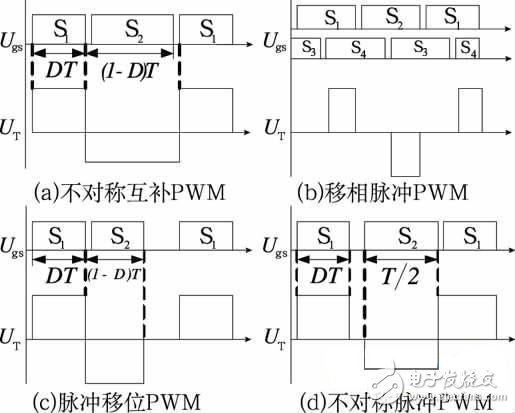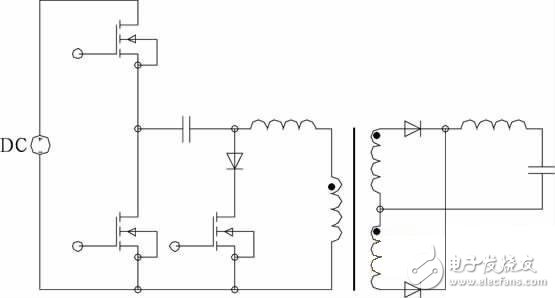The half-bridge circuit consists of two power switching device assemblies and provides a square wave signal to the outside. The DC-DC converter based on the half bridge is often used in the design of small and medium power circuits due to its simple structure and easy operation. As we all know, the common half-bridge controller usually has two control methods, one is symmetric control, and the other is asymmetric complementary control. This paper mainly analyzes the PWM control of the soft switch of half-bridge DC/DC converter. Strategy.
Control Soft Switch PWM Control Strategy
The control type soft-switching half-bridge DC/DC converter does not increase the main circuit components (the inductance and capacitance components can be increased to achieve soft switching conditions), and the soft switching is realized by rationally designing the control circuit. Figure 1 shows the PWM control strategy for four control-type soft-switching half-bridge DC/DC converters.

Figure 1 Controlled Soft Switch PWM Control Strategy
Asymmetric complementary pulse PWM control
The control pulse of the switch tube is asymmetrically complementary, and the traditional asymmetric half-bridge converter adopting this control strategy has been widely used in small and medium power applications. There are two ways to realize ZVS in the primary switching tube: load current ZVS mode and excitation current ZVS mode. The advantage is that both switches can realize ZVS; some measures to improve the soft switching condition of the phase-shifted full-bridge converter hysteresis arm can also be applied to the asymmetric half-bridge converter; there is no oscillation problem in the hard switch; Compared to a phase full bridge converter, there is no cycle energy. The disadvantages are: the voltage stress of the switch tube and the soft switch condition of the switch tube are inconsistent, the upper tube is difficult to realize soft switch; the voltage stress of the rectifier tube is inconsistent, and with the duty cycle change, the voltage of a rectifier tube is high in some applications, and the device is difficult Choice; soft switching conditions will be lost at light load; transformer DC bias, the heavier the load, the smaller the duty cycle, the more severe the bias magnet; it is not suitable for applications with wide input or wide output voltage.
Phase shift pulse PWM control
The half bridge using this control strategy is also called a dual active half bridge.
This control strategy is similar to the traditional phase-shifted full-bridge topology, except that the two arms of the phase shift are distributed on the primary and secondary sides of the transformer. In this topology, the leakage inductance of the transformer is the intermediate energy storage component. The original secondary side half bridges each generate a square wave with a duty ratio of 50%, and the output voltage is adjusted by adjusting the phase shift between the two bridges to control the energy of the leakage inductance of the transformer. This topology enables soft switching across the full load range while the output is synchronized. The disadvantage is that the circulating energy is very large and the output current ripple is large. In order to improve the disadvantage of large output current ripple, a phase-shifted ZVS half-bridge circuit is proposed.
Pulse shift PWM control
Pulse shift PWM control strategy. The falling edge of the upper tube is complementary to the leading edge of the lower tube, and the pulse width is the same. The ZVS of the lower tube can be opened, and the upper tube is still a hard switch. The advantages are: partial switching loss can be reduced; DC bias is not present in the transformer; the voltage stress of the rectifier is symmetrical; the wide range input is superior to the asymmetric half bridge. Adding an auxiliary circuit can realize the ZVS of the upper tube.
Asymmetric pulse PWM control
Asymmetric pulse PWM control, the lower edge of the lower tube is complementary to the leading edge of the upper tube, and the upper tube can realize ZVS. As long as the duty cycle of the design is small, no other measures are required, even if the switching at lower frequencies is small. The transformer is biased by DC, except for the end of the duty cycle, the bias current is smaller than the asymmetric half bridge. Wide range of applicability is superior to traditional asymmetric half bridges. Applications with low voltage and high current have certain advantages.
Buffered Soft Switching Symmetric PWM Control Strategy
Symmetrical control of the bi-directional converter core bi-directional magnetization, high utilization, and no bias. Control is convenient and the control characteristics are linear. The voltage stress on the power tube is low, which is suitable for high input voltage applications. However, such a half bridge converter is difficult to implement soft switching, and the converter efficiency is difficult to be improved.
Symmetric PWM Control ZVS Half Bridge Converter
A symmetric PWM controlled ZVS half-bridge converter (see Figure 2). Compared to a conventional half-bridge circuit, a symmetric PWM-controlled ZVS DC converter adds a branch consisting of an auxiliary switching transistor and a diode. The main switch tube not only works in a symmetrical state, but the down tube and the auxiliary switch tube can realize ZVS in the full load range, and the upper tube can also realize ZVS in a wide load range, resulting in little additional loss. The converter device is less stressed and has high reliability, and is more suitable for using a MOSFET as a switching tube, and is less used in high voltage and high power applications. The converter needs to use the energy storage of the resonant inductor to realize the ZVS of the switching tube. Increasing the resonant inductance can expand the ZVS range of the upper tube, but the duty cycle is seriously lost. When designing the resonant inductor, we must balance the consideration of the upper tube ZVS and the reduction. Small duty cycle is lost.

Figure 2 Symmetric PWM Control ZVS Half Bridge Converter
This article analyzes the PWM control mode of the soft-switch of the half-bridge DC/DC converter from various angles. Four PWM control strategies of controlled half-bridge DC/DC converter and PWM control strategy of buffered soft-switching half-bridge DC/DC converter are summarized in detail. The above PWM control strategy is deeply analyzed and comprehensively compared for selection. The basis for specific applications is provided.
Handheld Vacuum Cleaner: this Usb Vacuum cleaner is with small body and high efficiency, it is very easy for using and for storage in a small space. The vacuum cleaner not only can be used for cleaning cars, computers, keyboard, printer, office, pet food, but also can be used for cleaning other small household appliances. More important, with the beautiful design, this mini Rechargeable Vacuum Cleaner will be good scenery in the house. Choose it and you will like it.
Rechargeable wireless vacuum cleaner: this vacuum cleaner power supplied by usb port, which is very easy and convenient to use and store.
Easy to use: this mini vacuum cleaners` filter can be washed by water. Just open the dust pot and take it out, then wash it clean and use it again after it dry.
Handheld Vacuum Cleaner
Shark Handheld Vacuum,Portable Vacuum Cleaner,Hand Vacuum Cleaner,Cordless Handheld Vacuum
SHENZHEN HONK ELECTRONIC CO., LTD , https://www.honktech.com